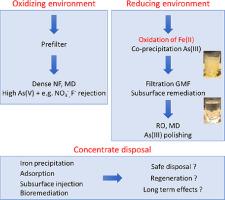Water Research ( IF 12.8 ) Pub Date : 2021-02-25 , DOI: 10.1016/j.watres.2021.116978 Edgardo E. Cañas Kurz , Ulrich Hellriege , Alberto Figoli , Bartolo Gabriele B , Jochen Bundschuh , Jan Hoinkis

|
Various technologies are used for the treatment of arsenic (As) contaminated water, but only a few seem to be suitable for small-scale applications; these are mostly used in rural communities where the access to potable water is the most vulnerable. In this review paper, the salient advantages and most notable challenges of membrane-based technologies for the removal of arsenate As(V) and arsenite As(III) are evaluated and systematically compared to alternative technologies such as e.g. adsorption. A comparison of different scientific papers, case studies and pilot trials is used to discuss the most important aspects when evaluating As mitigation technologies, including the ability to comply with the stringent WHO drinking water guideline limit value of 10 µg/L As and the safe disposal of produced As-laden waste. The use of renewable energies such as solar power in small-scale (<10 m³/day) membrane applications is evaluated. Finally, a conceptual approach for holistic As mitigation is proposed as an important approach to prevent exposure to As by providing a safe water supply.
中文翻译:

用于分散应用的基于膜的小规模砷去除–开发概念方法以供将来使用
各种各样的技术都用于处理砷(As)污染的水,但似乎只有少数技术适用于小规模的应用。这些主要用于农村社区,那里的饮用水最脆弱。在这篇综述文件中,对基于膜的技术去除砷酸砷(V)和砷酸砷(III)的显着优势和最显着挑战进行了评估,并与吸附等替代技术进行了系统比较。通过比较不同的科学论文,案例研究和试验性试验,来讨论评估砷减缓技术时最重要的方面,包括遵守严格的WHO饮用水准则限值10 µg / L As的能力和安全处置产生的含砷废物。评估了在小规模(<10立方米/天)膜应用中太阳能等可再生能源的使用。最后,提出了一种整体砷缓解的概念性方法,作为通过提供安全水源防止砷暴露的重要方法。



























 京公网安备 11010802027423号
京公网安备 11010802027423号